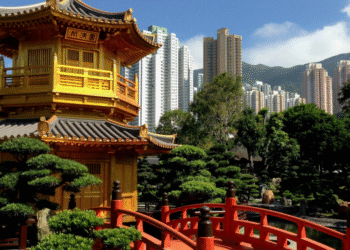Key Takeaways
- A Culinary Melting Pot: Discover why Hong Kong’s unique blend of Cantonese roots and international influences makes it a world-class food destination.
- Must-Try Dishes: Learn about iconic local eats beyond dim sum, including roast goose, wonton noodles, and clay pot rice.
- Dim Sum Decoded: Get an insider’s guide to the art of yum cha, from classic dishes like har gow and siu mai to the best traditional tea houses.
- Street Food Adventures: Explore the bustling street food scenes in Mong Kok and Temple Street Night Market, where you’ll find everything from fish balls to egg waffles.
- Local Dining Culture: Understand the unique experience of a cha chaan teng (Hong Kong-style café) and the etiquette of seafood dining in places like Sai Kung.
- Practical Tips: This complete Hong Kong food guide includes a sample itinerary, budget-friendly advice, and booking essentials to help you plan your trip.
 Introduction
Introduction
Welcome to Hong Kong, a city that breathes, dreams, and lives for food. As a local, I can tell you that our city’s rhythm is set not by clocks, but by meal times: the clatter of mahjong tiles fading as the first dim sum steamers hiss to life, the lunchtime rush for a bowl of hearty wonton noodles, and the electric sizzle of woks in a night market. Food here is more than just sustenance; it’s a language, a tradition, and a constant, thrilling adventure.
In this concrete jungle, every street corner, hidden alley, and gleaming skyscraper holds a culinary secret waiting to be discovered. From Michelin-starred restaurants to humble, family-run noodle shops, the diversity is staggering. This isn’t just a place to eat; it’s a place to experience flavors that tell the story of our heritage—a dynamic fusion of Cantonese tradition and colonial British influence, seasoned with flavors from across Asia and the world.
Forget what you think you know about Chinese food. Prepare to dive headfirst into a world of silky-smooth congee, succulent roast meats, delicate dim sum, and buttery pineapple buns. This guide is your personal invitation to eat like a local, to navigate the bustling markets with confidence, and to create memories one delicious bite at a time. So, bring your appetite and an open mind; Hong Kong is ready to feast with you.
Hong Kong’s Food Culture
Hong Kong’s culinary identity is a fascinating tapestry woven from history, geography, and culture. At its heart is traditional Cantonese cuisine, renowned for its emphasis on freshness and delicate, balanced flavors. We believe in letting the quality of the ingredients shine, whether it’s seafood straight from the tank or vegetables plucked from a nearby farm. This principle is the foundation of everything from the simplest steamed fish to the most elaborate banquet dishes.
But what makes our food scene truly unique is the “East-meets-West” dynamic. A legacy of its time as a British colony, Hong Kong developed a hybrid food culture that’s entirely its own. This is most evident in the beloved cha chaan teng, the quintessential Hong Kong-style café. Here, you’ll find creations like milk tea (a strong black tea mixed with evaporated or condensed milk), macaroni soup with ham, and French toast coated in egg and deep-fried. It’s comfort food that tells a story of adaptation and innovation.
This fusion extends beyond casual diners. You’ll see it in fine dining restaurants where French techniques are applied to Chinese ingredients, and in bakeries selling classic egg tarts alongside Swiss rolls. This constant dialogue between different culinary traditions makes Hong Kong one of Asia’s top foodie destinations. It’s a city that’s fiercely proud of its roots yet endlessly curious and open to the new, creating a vibrant, ever-evolving food landscape that always has something new to offer.
Iconic Hong Kong Dishes
While dim sum often steals the spotlight, Hong Kong’s culinary repertoire is vast and deeply satisfying. To truly eat like a local, you must venture beyond the bamboo steamers. Start with a bowl of wonton noodle soup. The perfect bowl has springy, thin noodles, flavorful broth, and plump wontons filled with fresh shrimp. It’s a deceptively simple dish that requires immense skill to master.
Next, you cannot leave without trying our roast meats, or siu mei. The holy trinity consists of char siu (barbecued pork), siu yuk (crispy-skinned roast pork belly), and roast goose. A proper roast goose has glistening, crackling skin and succulent, flavorful meat. For an unforgettable experience, visit a legendary spot like Yat Lok, where the quality is consistently exceptional.
As the weather cools, locals flock to eateries serving clay pot rice, or bo zai fan. Cooked over a charcoal stove, the rice forms a crispy, coveted crust at the bottom of the pot, while the top is steamed with toppings like Chinese sausage, chicken, and preserved duck. The final drizzle of sweet soy sauce brings it all together. It’s a heartwarming, communal dish that embodies the soul of Cantonese comfort food.
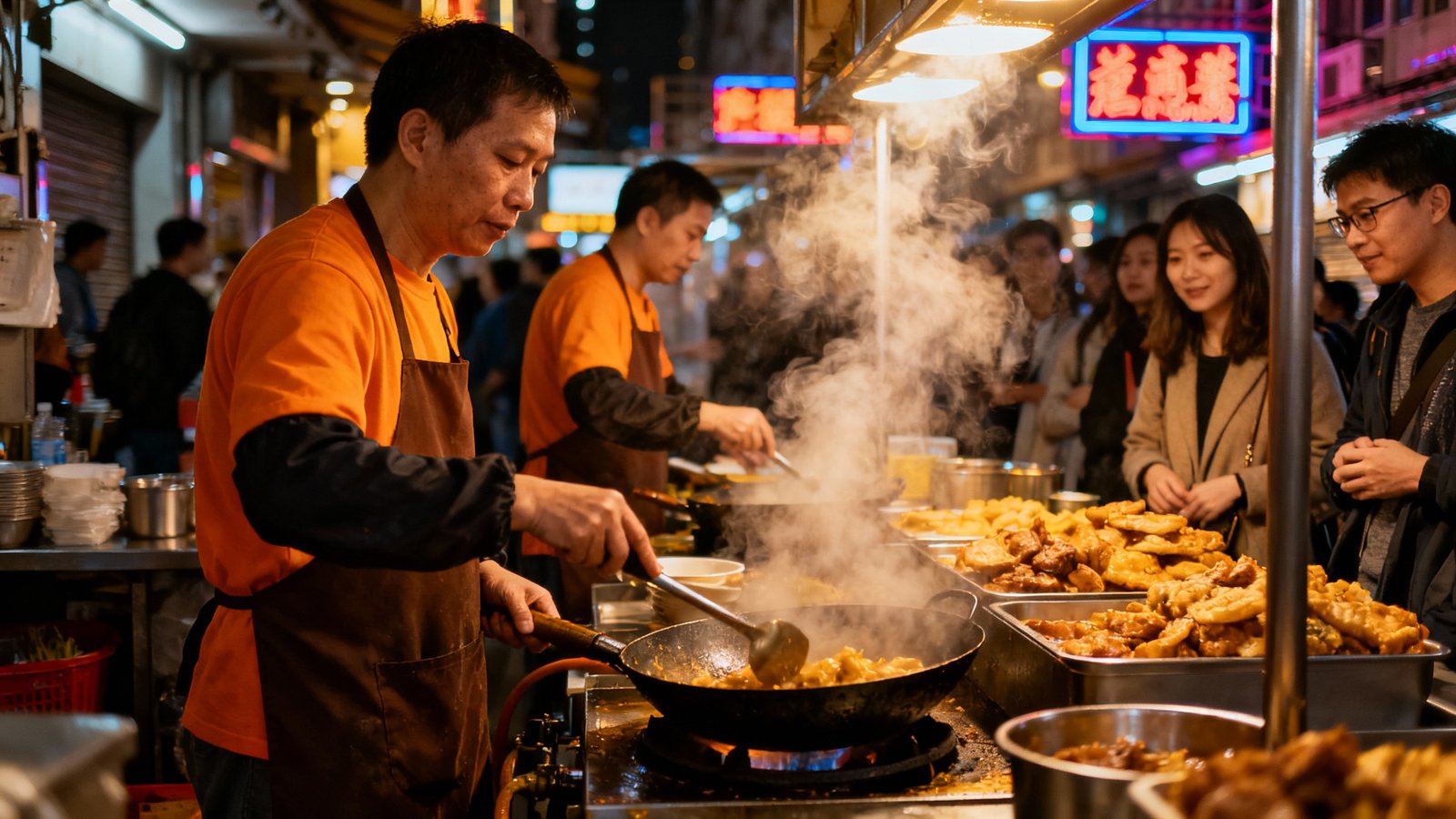
Dim Sum Classics
Yum cha, which literally translates to “drink tea,” is the quintessential Hong Kong brunch experience. It’s a leisurely, social affair where families and friends gather to chat over pots of tea and a parade of small, delectable dishes known as dim sum. The tradition dates back to the days of the Silk Road, when tea houses offered travelers a place to rest and have a small bite.
When the dim sum carts roll by or you get your checklist, there are a few non-negotiable classics you must order. Har gow (steamed shrimp dumplings) are the ultimate test of a dim sum chef’s skill; the wrapper should be translucent and chewy, encasing a plump, juicy shrimp. Equally essential is siu mai, a steamed pork and shrimp dumpling, often topped with a dot of orange crab roe.
No dim sum meal is complete without char siu bao, fluffy steamed buns filled with sweet, savory barbecued pork. For something crispy, try the pan-fried turnip cake (lo bak go) or the spring rolls. The beauty of dim sum is the variety; you can order dozens of different items to share, creating a symphony of flavors and textures. It’s a culinary experience that’s meant to be savored slowly, one bamboo basket at a time.
Famous Dim Sum Restaurants
Navigating the world of dim sum can be overwhelming, but a few legendary establishments offer a perfect introduction. For a taste of Michelin-starred quality without the hefty price tag, Tim Ho Wan is a must-visit. Known as the world’s cheapest Michelin-starred restaurant, its baked BBQ pork buns are legendary—a crispy, sweet bun giving way to a savory pork filling.
For a journey back in time, seek out Lin Heung Tea House. This is one of the last remaining old-school dim sum parlors where ladies still push traditional trolleys laden with bamboo steamers through the crowded hall. It’s loud, chaotic, and utterly authentic. You’ll have to be assertive to flag down the carts and grab what you want, but it’s an experience that’s quintessentially Hong Kong.
If you’re looking for a more refined and comfortable setting, Maxim’s Palace at City Hall offers a grand dim sum experience with stunning views of Victoria Harbour. The quality is excellent, the service is more formal, and they also use traditional push-carts, providing a nice balance between authenticity and comfort. It’s a great option for a special occasion or for those new to the yum cha scene.
Street Food Adventures
To feel the true pulse of Hong Kong, you must dive into its street food culture. The city’s liveliest districts, like Mong Kok and Sham Shui Po, are treasure troves of cheap, delicious, and unforgettable snacks. As dusk falls, these neighborhoods come alive with the glow of food stalls, the sizzle of grills, and the chatter of hungry locals and tourists.
In Mong Kok, you can embark on a culinary safari, sampling everything from curry fish balls on a stick to stinky tofu (an acquired taste, but a local favorite). Don’t miss the egg waffles, or gai daan zai, a sweet, bubbly waffle that’s crispy on the outside and soft on the inside. Another must-try is grilled squid tentacles, seasoned with a mix of spices that will have you coming back for more.
For a more concentrated experience, head to the Temple Street Night Market. While known for its shopping, the market is also a fantastic place for a casual seafood dinner at one of the open-air dai pai dong stalls. Grab a plastic stool, order some spicy razor clams, salt and pepper squid, and a cold beer, and soak in the vibrant, noisy atmosphere. This is Hong Kong at its most raw and exciting.

Local Cafés & Cha Chaan Teng
A visit to Hong Kong is incomplete without experiencing a cha chaan teng. These Hong Kong-style diners are fast, affordable, and wonderfully chaotic institutions. They are the backbone of the city’s dining culture, serving a unique menu of Canto-Western hybrid dishes from dawn until late at night. The décor is usually no-frills, the service is lightning-fast, and the experience is pure Hong Kong.
The quintessential cha chaan teng order is a set meal that includes a main dish, a drink, and sometimes a soup. For the full experience, you must try the Hong Kong-style milk tea, a strong, robust brew strained through a silk stocking-like filter, giving it an incredibly smooth texture. Pair it with a pineapple bun (bo lo bau), a soft, sweet bun with a crunchy, sugary top crust that resembles a pineapple (it contains no actual pineapple!). For the ultimate indulgence, get it with a thick slab of cold butter inside (bo lo yau).
For a more substantial meal, baked pork chop rice is a beloved classic—a hearty dish of egg-fried rice topped with a thick pork chop and a tangy tomato sauce, all baked with a layer of cheese. Another favorite is macaroni soup with ham or Spam, a simple yet comforting breakfast staple. For a classic experience, try a place like Australia Dairy Company, famous for its scrambled eggs and steamed milk pudding.
Seafood & Harbourfront Dining
Being a coastal city, Hong Kong boasts an incredible seafood scene. For the freshest and most authentic experience, locals head to the outlying fishing villages of Sai Kung and Lei Yue Mun. Here, you can wander along the waterfront, selecting your live seafood directly from the tanks of fishermen and fishmongers. You then take your catch to one of the nearby restaurants, which will cook it for you according to your preference—steamed, fried, with garlic and chili, or in a black bean sauce.
Sai Kung, known as the “back garden of Hong Kong,” offers a beautiful seaside setting for a leisurely seafood feast. The promenade is lined with excellent restaurants, such as the renowned Chuen Kee Seafood Restaurant, where you can dine al fresco with views of the harbor. Popular dishes include steamed fish with ginger and scallions, salt and pepper mantis shrimp, and cheese-baked lobster. It’s a fantastic way to spend an afternoon or evening away from the city bustle.
Lei Yue Mun offers a similar experience but in a more traditional, village-like setting. Walking through its narrow lanes, past the bustling seafood stalls, feels like stepping back in time. The experience of choosing your own dinner from a bubbling tank and having it cooked to perfection moments later is a core part of Hong Kong’s food culture. It’s a celebration of freshness and a truly memorable dining adventure.
Sweet Treats & Desserts
Hong Kong’s love affair with food extends well into the realm of desserts. After a savory meal, locals often head to a tong sui (sweet soup) shop to satisfy their sweet tooth. These dessert parlors serve a huge variety of hot and cold sweet soups, puddings, and other treats that are a core part of our culinary identity.
One of the most iconic desserts is the Hong Kong-style egg tart. With its flaky pastry crust and wobbly, sweet egg custard filling, it’s a perfect afternoon snack, best enjoyed warm from the bakery. There are two main varieties: one with a shortcrust pastry and another with a puff pastry. Trying both to find your favorite is a delicious mission.
Another beloved dessert, especially in the warmer months, is mango pomelo sago. This refreshing concoction is a creamy blend of mango puree, coconut milk, sago pearls, and chunks of fresh mango and pomelo. For something more traditional, try dou fu fa, a silky-smooth tofu pudding served with a sweet ginger or sugar syrup. Whether you crave something fruity, creamy, or traditional, Hong Kong’s dessert scene has a sweet ending for every meal.
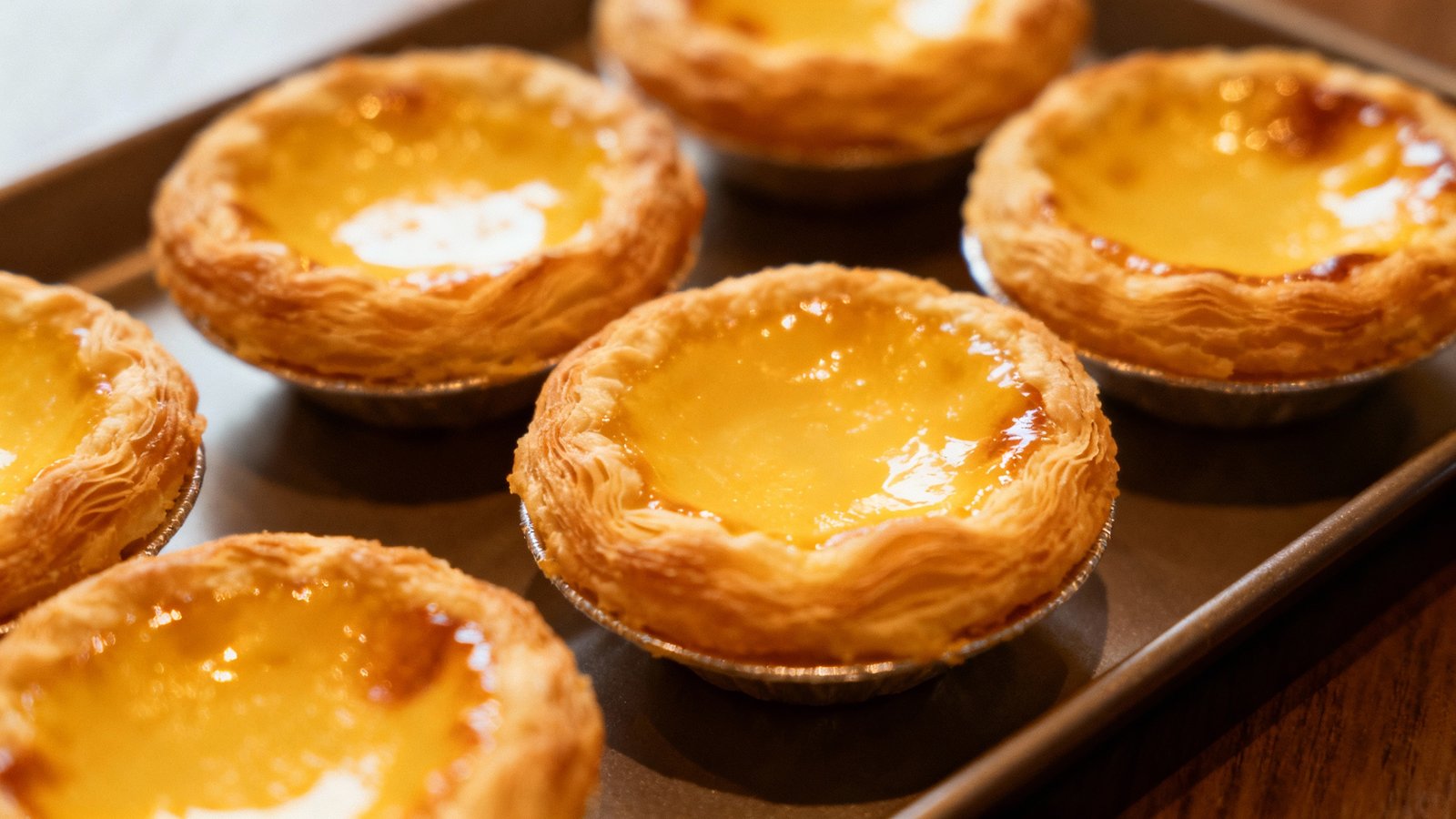
Vegetarian & Vegan Options
While Hong Kong cuisine is traditionally meat-heavy, the city’s vegetarian and vegan scene is growing and thriving. You can find everything from dedicated vegan cafes to traditional Buddhist vegetarian restaurants that have been serving plant-based meals for decades. These restaurants are masters of imitation, creating incredible “mock meat” dishes out of tofu, mushrooms, and gluten that can fool even the most ardent carnivores.
For a serene and unique dining experience, visit Chi Lin Vegetarian, located within the beautiful Nan Lian Garden. Here, you can enjoy a sophisticated multi-course vegetarian meal while looking out at a tranquil waterfall. The menu is creative and delicious, proving that vegetarian food can be just as complex and satisfying as any meat-based dish.
Even on the streets, you can find vegetarian options. Many street food stalls offer snacks like roasted chestnuts, sweet potatoes, and corn on the cob. Some modern stalls are also starting to offer vegan versions of classics like siu mai. With a little research, vegetarian and vegan travelers will find that Hong Kong has a wealth of delicious plant-based options to explore.
Food Markets & Local Groceries
To truly understand Hong Kong’s food culture, you need to visit a wet market. These bustling, chaotic markets are where locals shop for their daily groceries, from fresh vegetables and fruits to live seafood and freshly butchered meat. The sights, sounds, and smells can be intense, but it’s an authentic slice of local life that food lovers shouldn’t miss.
Graham Street Market is one of the oldest continuously operating street markets in Hong Kong. Stretching along a steep hill in Central, it’s a vibrant jumble of stalls selling everything from fresh produce to traditional sauces and preserved goods. It’s a fantastic place for photography and to witness the daily routines of local residents and chefs.
Another great market to explore is the Wan Chai Market. It’s a mix of an indoor market building and outdoor street stalls, offering a huge variety of goods. Exploring these markets gives you an appreciation for the local emphasis on freshness. You’ll see grandmothers carefully selecting vegetables, butchers expertly cleaving meat, and fishmongers scaling fish with lightning speed. It’s the living, breathing heart of the city’s food supply chain.
Cooking Classes & Food Tours
After tasting all the incredible food Hong Kong has to offer, you might be inspired to learn how to make it yourself. Joining a cooking class is a fantastic way to get a hands-on understanding of Cantonese cuisine. Many classes focus on dim sum making, where you can learn the delicate art of folding har gow or filling siu mai from an expert chef.
These classes often include a trip to a local wet market to learn about the key ingredients, providing a deeper connection to the food you’re preparing. It’s a fun, interactive experience that leaves you with a new skill and a full stomach. You’ll gain a newfound appreciation for the craftsmanship that goes into each tiny, perfect dumpling.
If you’d rather leave the cooking to the experts but still want a guided experience, a food tour is an excellent option. A local guide can lead you through the maze-like streets to hidden gems and explain the history and culture behind the dishes you’re tasting. Whether you’re exploring the street food of Sham Shui Po or the Michelin-starred eateries of Central, joining a guided food tour can unlock a side of the city’s food scene you might not find on your own.
Tea Culture in Hong Kong
Tea is the silent partner in Hong Kong’s most famous culinary tradition, yum cha. While the dim sum dishes take center stage, the tea is just as important. It cleanses the palate between bites and aids in digestion, making it the perfect complement to the rich and varied flavors of the food. When you sit down for dim sum, the first thing you’ll be asked is what kind of tea you’d like.
Popular choices include bo lei (a dark, earthy fermented tea), jasmine (heung pin), and oolong (tit gwun yam). There’s a simple etiquette to follow: when someone pours tea for you, tap the table with two fingers as a silent gesture of thanks. If your pot is empty, simply leave the lid ajar, and a server will promptly refill it with hot water.
Beyond the boisterous dim sum halls, you can also find quiet, traditional tea houses that focus on the art of tea appreciation. These serene spaces offer a respite from the city’s hustle, allowing you to sample rare and high-quality teas brewed with precision and care. It’s a chance to slow down and appreciate a practice that has been central to Chinese culture for centuries.

Where to Stay for Food Lovers
Choosing the right neighborhood to stay in can significantly enhance your culinary journey in Hong Kong. For relentless food action, base yourself in Mong Kok or Jordan in Kowloon. These areas are packed with street food stalls, local eateries, and bustling markets, meaning you’re never more than a few steps away from a delicious bite, day or night.
If you prefer a mix of trendy restaurants, classic diners, and upscale bars, Central and Sheung Wan on Hong Kong Island are excellent choices. These districts are home to some of the city’s best fine dining, hidden speakeasies, and historic food landmarks like Graham Street Market. You’ll have easy access to the Mid-Levels Escalator, which is lined with dining options.
Tsim Sha Tsui is another fantastic hub for foodies, offering a vast range of options from all over the world, alongside plenty of authentic Cantonese restaurants. Its proximity to Victoria Harbour also means many restaurants offer spectacular views. No matter where you choose, finding the perfect hotel for your foodie adventure is easy, thanks to the city’s compact nature and excellent public transport.
Day Trips for Food Explorers
If you have an extra day, consider a food-focused day trip to explore the culinary landscapes beyond the city center. A ferry ride to Macau offers a completely different but equally fascinating food experience. A former Portuguese colony, Macau has its own unique Macanese cuisine—a fusion of Portuguese and Chinese flavors. Don’t leave without trying the famous Macanese egg tart (which has a more caramelized top than its Hong Kong counterpart) and the African chicken.
For a more rustic adventure, take a bus or ferry to Tai O Fishing Village on Lantau Island. This charming village of stilt houses offers a glimpse into Hong Kong’s past. The specialty here is shrimp paste, and you can also find a variety of dried seafood and other local snacks. A guided tour of the village can provide fascinating insights into the local way of life and its unique food traditions.
These day trips offer a refreshing change of pace and a chance to taste flavors that are distinct from those in the urban heart of Hong Kong. They showcase the surprising diversity of the Pearl River Delta region and add another delicious layer to your culinary exploration.
Getting Around for Food Experiences
Hong Kong’s public transportation system is a food lover’s best friend. It’s efficient, clean, and connects you to virtually every culinary corner of the city. The Mass Transit Railway (MTR) is the fastest way to travel between major districts. Get an Octopus card upon arrival; you can use it to tap and go on the MTR, buses, trams, and even pay at convenience stores and some fast-food outlets.
The iconic double-decker trams, or “ding-dings,” offer a slow, scenic, and incredibly cheap way to travel across Hong Kong Island. Hop on and grab a seat on the top deck for a fantastic view of the city’s vibrant street life as you trundle between foodie neighborhoods like Wan Chai, Causeway Bay, and Central.
Ferries, especially the famous Star Ferry crossing Victoria Harbour, are another essential experience. They not only provide stunning views but also connect you to the culinary delights of both Kowloon and Hong Kong Island. While public transport is superb, some visitors exploring the New Territories might consider flexible car rentals for reaching more remote villages and seafood towns at their own pace.
Budget-Friendly Food Tips
Eating your way through Hong Kong doesn’t have to break the bank. In fact, some of the city’s best food is also its cheapest. A key strategy is to eat like a local. Look for the small, crowded eateries with menus only in Chinese—it’s often a sign of authentic, affordable, and delicious food. Don’t be afraid to point and order!
Take advantage of lunch sets, which are offered by many restaurants on weekdays. They typically include a main course, a drink, and sometimes a soup for a fraction of the dinner price. For payments, while most larger restaurants accept credit cards, smaller eateries and street food stalls are cash-only. It’s wise to carry some Hong Kong dollars with you. For better exchange rates than you’ll find at airport kiosks, consider using a modern currency exchange service before your trip.
Finally, embrace the culture of sharing. Portions are often generous, and ordering several dishes to share among your group allows you to sample a wider variety of flavors without over-ordering or over-spending. This is especially true for dim sum and at dai pai dong stalls.
Travel Insurance & Booking Essentials
Planning a food-centric trip is exciting, but it’s wise to handle the practicalities first. Securing your flights to Hong Kong well in advance can often save you money, leaving more in your budget for an extra dim sum basket or two. Once you’ve landed, you’ll be eager to start your culinary journey, but it’s important to be prepared for the unexpected.
This is where travel insurance becomes essential. When you’re indulging in new and exotic foods, there’s always a small risk of an upset stomach or an allergic reaction. Having comprehensive travel insurance provides peace of mind, ensuring that if you do need medical attention, you’re covered without facing hefty bills. It’s a small investment for a worry-free trip.
Beyond health, good insurance also protects you against travel mishaps like lost luggage or flight cancellations. It’s the safety net that allows you to fully immerse yourself in the adventure of exploring Hong Kong’s incredible food scene without any lingering worries. So, book your flights, secure your insurance, and get ready to feast.
Sample 3-Day Food Itinerary
Day 1: Classic Kowloon
- Morning: Start with a classic dim sum breakfast at Tim Ho Wan in Sham Shui Po.
- Afternoon: Explore the street food of Mong Kok. Grab curry fish balls, egg waffles, and stinky tofu.
- Evening: Head to the Temple Street Night Market for an atmospheric dai pai dong seafood dinner.
Day 2: Hong Kong Island Icons
- Morning: Experience a traditional cha chaan teng breakfast at Australia Dairy Company (be prepared to queue!).
- Afternoon: Wander through Graham Street Market, then enjoy a famous roast goose lunch at Yat Lok in Central.
- Evening: Have a refined vegetarian dinner at Chi Lin Vegetarian in Diamond Hill, followed by a stroll through the beautiful Nan Lian Garden.
Day 3: Seaside Flavors & Sweet Endings
- Morning: Take a day trip to Sai Kung. Choose your own live seafood from the waterfront stalls.
- Afternoon: Enjoy a magnificent seafood feast at a restaurant on the promenade.
- Evening: Return to the city and indulge in a dessert crawl in Causeway Bay, sampling mango pomelo sago, egg tarts, and traditional sweet soups.
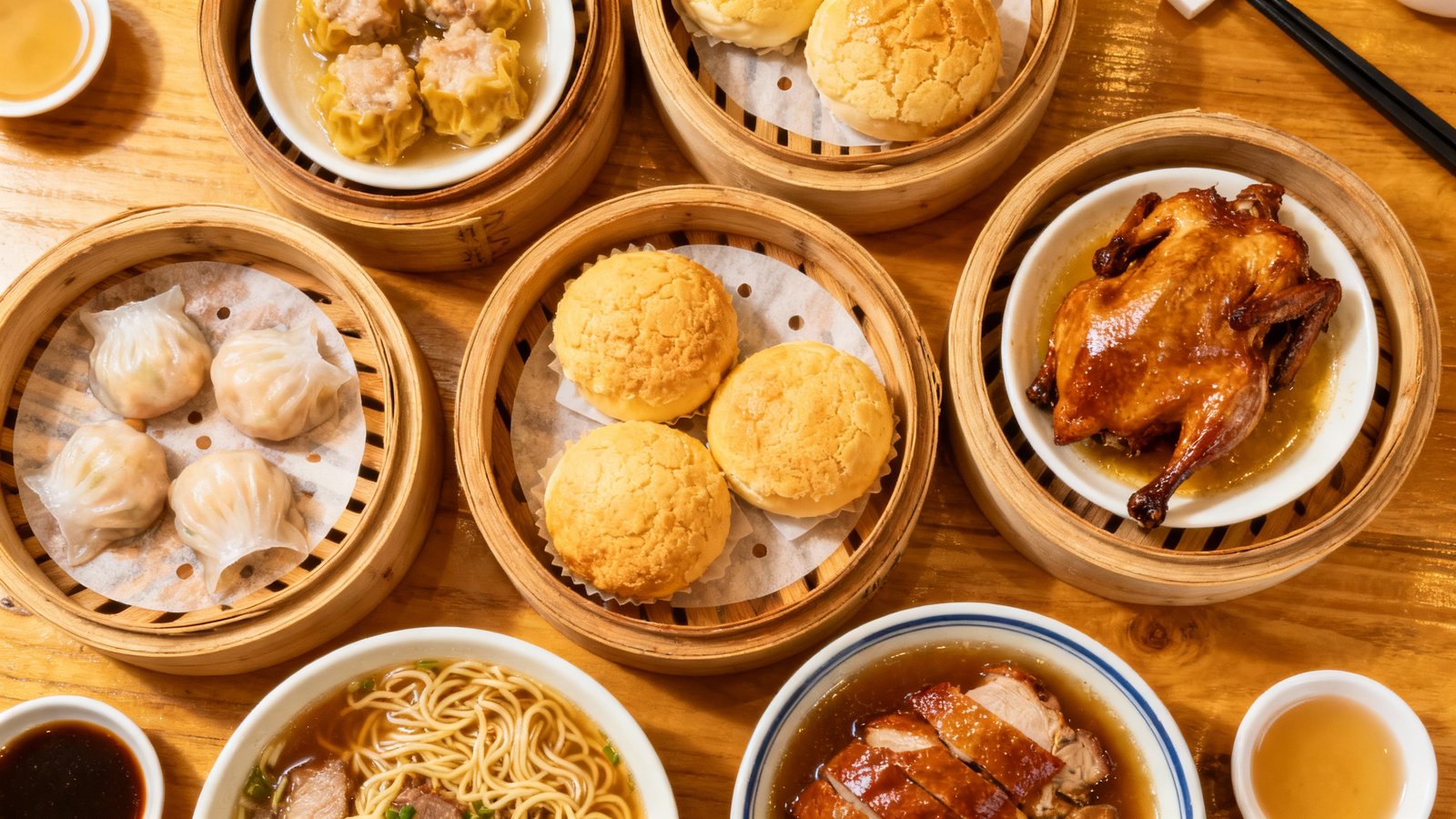
Conclusion
Hong Kong is not just a city you visit; it’s a city you taste. From the first sip of silky milk tea in a bustling cha chaan teng to the last bite of a delicate shrimp dumpling, every meal tells a story. It’s a narrative of tradition, innovation, and an unwavering passion for good food that permeates every corner of this incredible metropolis. The energy of the street markets, the comforting chaos of a dim sum hall, and the simple joy of a warm pineapple bun are experiences that stay with you long after you’ve left.
This Hong Kong food guide is more than just a list of dishes; it’s an invitation to connect with the soul of our city. It’s about being adventurous, trying something new, and sharing in the communal joy that defines our dining culture. Whether you’re a seasoned foodie or a curious traveler, the culinary landscape of Hong Kong offers endless opportunities for discovery and delight. It’s a place where food is not just consumed but celebrated.
So, come with an empty stomach and an open heart. Let the aromas guide you through winding alleys and up gleaming skyscrapers. The ultimate foodie paradise is waiting for you. When you’re ready to turn these culinary dreams into reality, let TripVista360 help you plan and book your perfect foodie adventure.
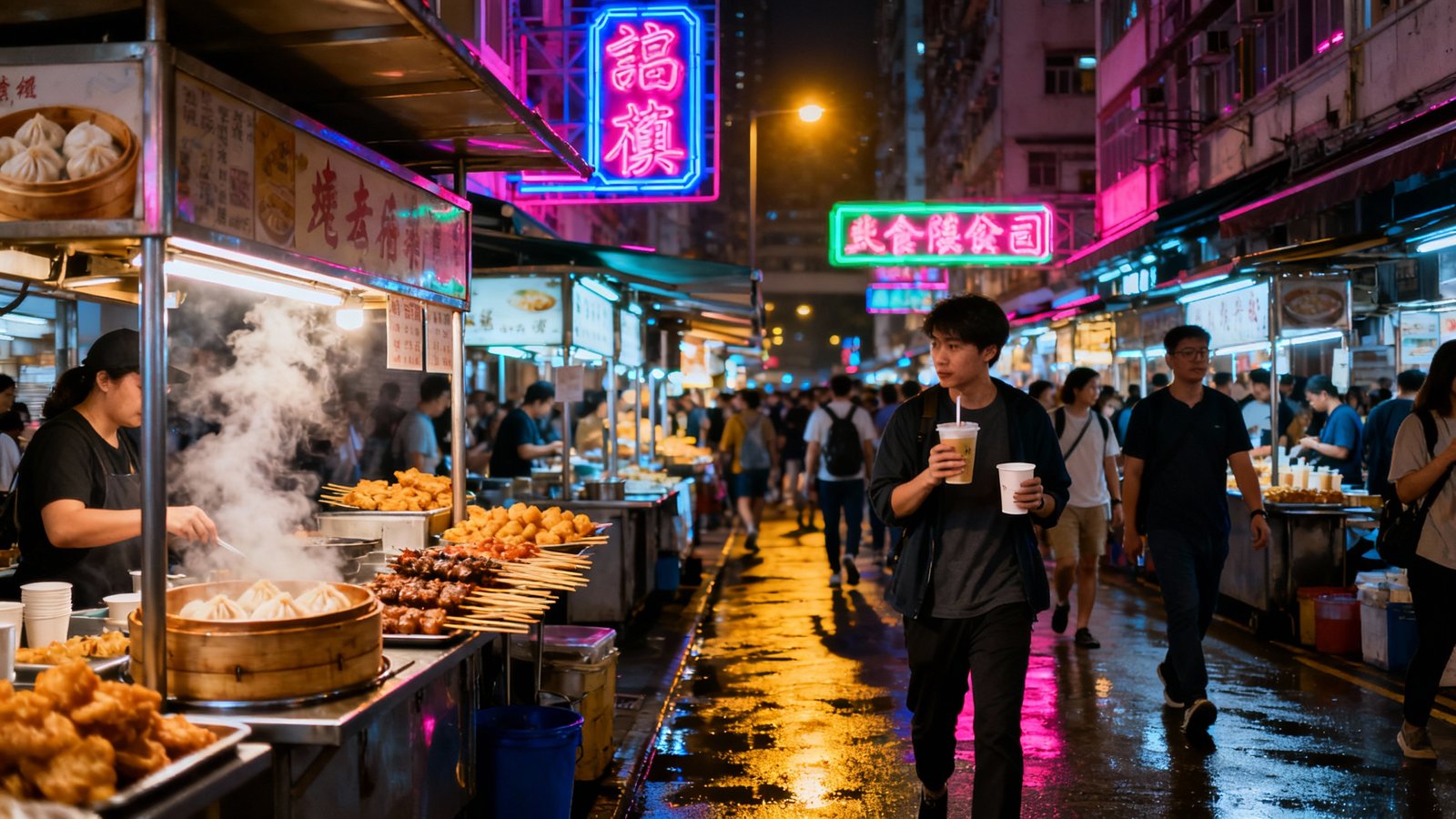
FAQs
1. What is a must-try food in Hong Kong for a first-time visitor?
Dim Sum is an absolute must. It’s the quintessential Hong Kong dining experience. Start with the classics: har gow (shrimp dumplings), siu mai (pork dumplings), and char siu bao (BBQ pork buns).
2. Is it safe to eat street food in Hong Kong?
Yes, it is generally very safe. Hong Kong has high food hygiene standards. As a rule of thumb, choose stalls that are busy and popular with locals—it’s a good sign that the food is fresh and delicious.
3. Do I need to speak Cantonese to order food?
While it’s appreciated, it’s not necessary in most places. In tourist-heavy areas and larger restaurants, menus often have English translations and pictures. In smaller local eateries, you can always point to what you want.
4. What is a cha chaan teng?
A cha chaan teng is a Hong Kong-style café known for its affordable and unique Canto-Western fusion dishes. It’s the place to go for milk tea, pineapple buns, and baked pork chop rice.
5. How much should I budget for food per day in Hong Kong?
It varies greatly. You can eat very well on a budget of HK$200-300 (US$25-40) per day by sticking to local eateries and street food. For mid-range restaurants and a few splurges, a budget of HK$500-700 (US$65-90) is more realistic.
6. What is the tipping etiquette in Hong Kong?
Tipping is not mandatory or widely practiced. Most restaurants will add a 10% service charge to the bill. In smaller eateries and taxis, tipping is not expected, but you can round up the bill if you wish.
7. Are vegetarian and vegan options easily available?
Yes, the scene is growing. While traditional cuisine is meat-focused, there are many dedicated vegetarian restaurants (often Buddhist style) and modern vegan cafes. Most restaurants can also accommodate vegetarian requests if you ask.
8. What is an Octopus card and do I need one for food?
An Octopus card is a rechargeable smart card used for public transport. It’s also accepted at many convenience stores, supermarkets, and fast-food chains. It’s extremely convenient and highly recommended for any visitor.



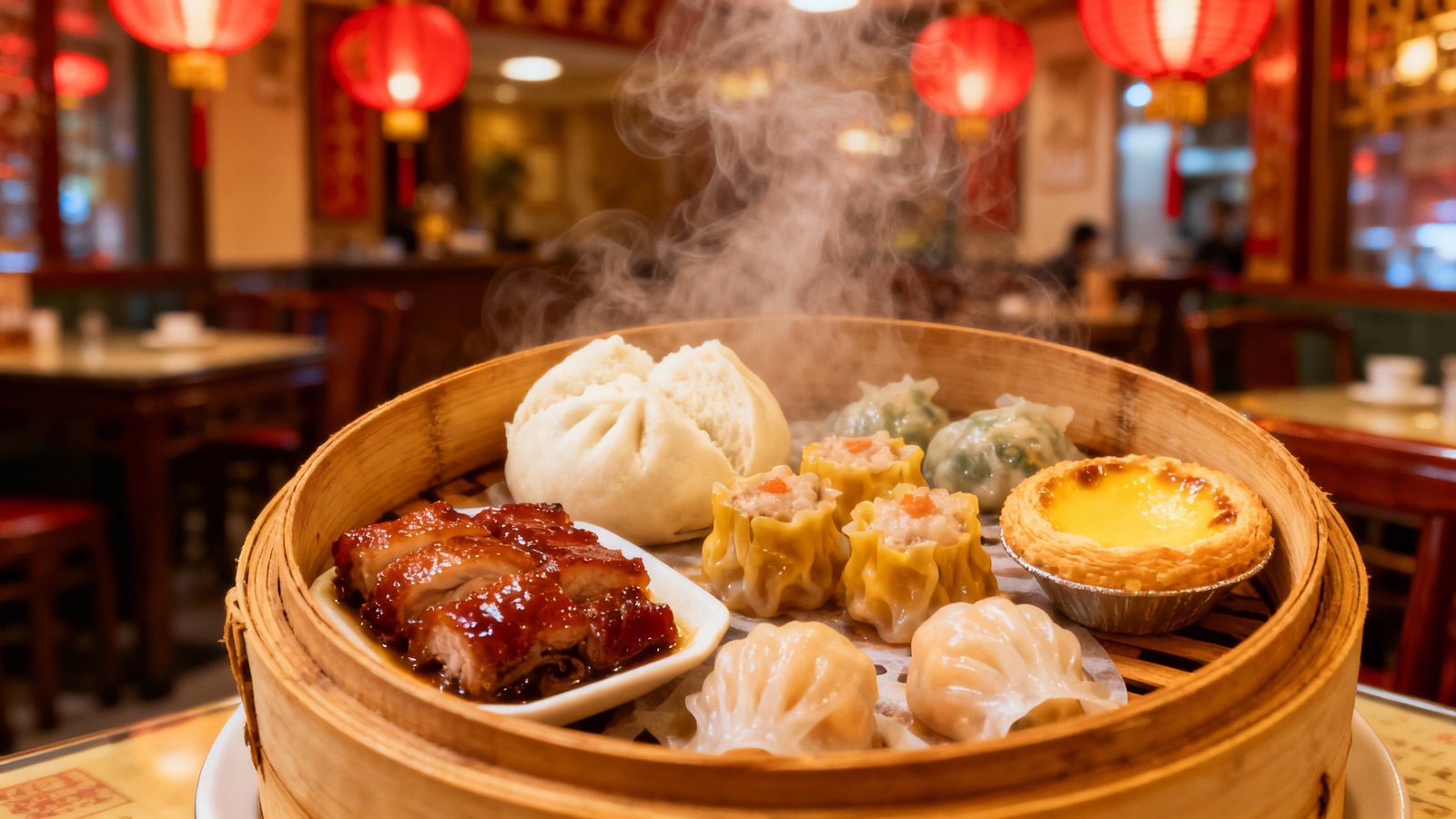 Introduction
Introduction